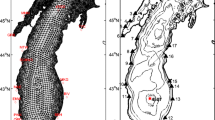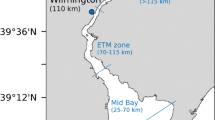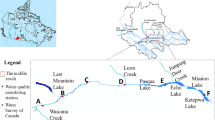Abstract
Ecological models have often been used in order to answer questions that are in the limelight of recent researches such as the possible effects of climate change. The methodology of tactical models is a very useful tool comparison to those complex models requiring relatively large set of input parameters. In this study, a theoretical strategic model (TEGM) was adapted to the field data on the basis of a 24-year long monitoring database of phytoplankton in the Danube River at the station of Göd, Hungary (at 1669 river kilometer - hereafter referred to as “rkm”). The Danubian Phytoplankton Growth Model (DPGM) is able to describe the seasonal dynamics of phytoplankton biomass (mg L−1) based on daily temperature, but takes the availability of light into consideration as well. In order to improve fitting, the 24-year long database was split in two parts in accordance with environmental sustainability. The period of 1979–1990 has a higher level of nutrient excess compared with that of the 1991–2002. The authors assume that, in the above-mentioned periods, phytoplankton responded to temperature in two different ways, thus two submodels were developed, DPGM-sA and DPGM-sB. Observed and simulated data correlated quite well. Findings suggest that linear temperature rise brings drastic change to phytoplankton only in case of high nutrient load and it is mostly realized through the increase of yearly total biomass.
Similar content being viewed by others
References
Adrian R., Deneke R., Mischke U., Stellmacher R. & Lederer P. 1995. A long-term study of the Heilingensee (1975–1992). Evidence for effects of climatic change on the dynamics of eutrophied lake ecosystems. Archiv fur Hydrobiol. 133: 315–337.
Allan J.D. & Castillo M.M. 2007. Stream Ecology: Structure and Function of Running Waters. Second edition. Springer, The Netherlands
Andersen H.E., Kronvang B., Larsen S.E., Hoffmann C.C., Jensen T.S. & Rasmussen E.K. 2006. Climate-change impacts on hydrology and nutrients in a Danish lowland river basin. Science Total Environ. 365: 223–237.
Anneville O., Molinero J.C., Souissi S. & Gerdeaux D. 2010. Seasonal and interannual variability of cladoceran communities in two peri-alpin lakes: uncoupled response to the 2003 heat wave. J. Plankton Res. 32(6): 913–925.
Barinova S., Medvedeva L. & Nevo E. 2008. Regional influences on algal biodiversity in two polluted rivers (Rudnaya River, Russia, and Quishon River, Israel) by bioindication and canonical correspondence analysis. Applied Ecol. Environ. Res. 6(4): 29–59.
Behrendt H., Van Gils J., Schreiber H. & Zessner M. 2005. Point and diffuse nutrient emissions and loads in the transboundary Danube River Basin. — II. Long-term changes. Large Rivers 16/1–2. Arch. Hydrobiol. Suppl. 158(1–2): 221–247.
Blenckner T., Omstedt A. & Rummukainen M. 2002. A Swedish case study of contemporary and possible future consequences of climate change on lake function. Aquatic Sci. 64(2): 171–184.
Csathó P., Sisák I., Radimszky L., Lushaj S., Spiegel H., Nikolova M.T., Nikolov N. Čermák P., Klir J., Astover A., Karklins A., Lazauskas S., Kopiński J., Hera C., Dumitru E., Manojlovic, M., Bogdanović D., Torma S., Leskošek M. & Khristenko A. 2007. Agriculture as a source of phosphorus causing eutrophication in Centra and Eastern Europe. British Society of Soil Science Suppl. 23: 36–56.
Déri A. 1991. The role of nitrification the oxygen depletion of the River Danube. Verh. Internat.Verein.Limnol. 24: 1965–1968.
Diós N., Szenteleki K., Ferenczy A., Petrányi G. & Hufnagel, L. 2009. A climate profile indicator based comparative analysis of climate change scenarios with regard to maize (Zea mays L) culures. Appl. Ecol. Environ. Res. 7(3): 199–214.
Drégelyi-Kiss Á., Drégelyi-Kiss G. & Hufnagel L. 2008. Ecosystems as climate controllers — biotic feedbacks (a review). Appl. Ecol. Environ. Res. 6(2): 111–135.
Drégelyi-Kiss Á & Hufnagel L. 2009a. Simulations of Theoretical Ecosystem Growth Model (TEGM) during various climate conditions. Appl. Ecol. Environ. Res. 7(1): 71–78.
Drégelyi-Kiss Á. & Hufnagel L. 2009b. Effects of temperature-climate patterns on the production of some competitive species on grounds of modeling. Environ. Model. Assessm. 15(5): 369–380.
Elliott J.A., Thackeray S.J., Huntingford C. & Jones R.G. 2005. Combining a regional climate model with a phytoplankton community model to predict future changes in phytoplankton in lakes. Freshwater Biol. 50: 1404–1411.
Felföldy L. 1981. A vizek környezettana. általános hidrobiológia. Mezőgazdasági Kiadó, Budapest.
Flanagan K.M., McCauley E., Wrona F. & Prowse T. 2003. Climate change: the potential for latitudinal effects on algal biomass in aquatic ecosystems. Can. J. Fish Aquat. Sci. 60: 635–639.
Gooseff M.N, Strzepek K. & Chapra S.C. 2005. Modeling the potential effects of climate change on water temperature downstream of a shallow reservoir, Lower Madison River, MT. Climatic Change 68(3): 331–353.
Hammer O., Harper D.A.T. & Ryan P.D. 2001. PAST: Paleontological statistics software package for education and data nalysis. Paleontologia Electronica 4(1): 9.
Hartman M.D., Baron J.S. & Ojima D.S. 2006. Application of a coupled ecosystem-chemical equilibrium model, DayCent-Chem, to stream and soil chemistry in a Rocky Mountain watershed. Ecological Modeling 200: 493–510.
Hassen H., Hanaki K. & Matsuo T. 1998. A modeling approach to simulate impact of climate change lake water quality: phytoplankton growth rate assessment. Water Sci. Technol. 37(2): 177–185.
Hostetler S.W. & Small E.E. 1999. Response of North American freshwater lakes to simulated future climates. J. Amer. Water Resour. Associat. 35(6): 1625–1637.
Horváth, L. & Tevanné-Bartalis É. 1999. A vízkémiai viszonyok jellemzése a Duna Rajka-Szob közötti szakaszán. Vízügyi Közlemények 81: 54–85.
Hufnagel L. & Gaál M. 2005. Seasonal dynamic pattern analysis service of climate change research. Appl. Ecol. Environ. Res. 3(1): 79–132.
Hufnagel L., Drégelyi-Kiss G. & Drégelyi-Kiss Á. 2010. The effect of the reproductivity’s velocity on the biodiversity of a theoretical ecosystem. Appl. Ecol. Environ. Res. 8(2): 119–130.
ICPDR 2005. The Danube River Basin District. Part A. Basinwide overview. http://www.icpdr.org/pub.
Kaur R. 2007. Planning length of long-term field experiments though decision support systems — a case study. Appl. Ecol. Environ. Res. 6(2): 63–78.
Kiss K.T. 1994. Trophic level and eutrophication of the River Danube in Hungary. Verh. Internat. Verein. Limnol. 25: 1688–1691.
Kiss K.T. 1996. Diurnal change of planktonic diatoms in the River Danube near Budapest (Hungary). Arch. Hydrobiol. Algol. Studies 80: 113–122.
Kiss K.T. & Genkal S.I. 1996. Phytoplankton of the Danube’s reservoirs in September 1995 from Germany to Hungary. In: Berczik Á. (ed.), Limnologische Berichte Donau 1996. 1: 143–148. MTA ÖBKI Magyar Dunakutató állomás, Vácrátót/Göd. ISBN 963 8391 20 0.
Kiss K.T. & Schmidt A. 1998. Changes of the Chlorophyta species in the phytoplankton of the Hungarian Section of the Danube river during the last decades (1961–1997). Biologia 53: 509–518.
Kiss K.T., Ács É. & Szabó K.É. 2007. Algák és anyagforgalmi kapcsolataik, pp. 33–49. In: Nosek J. & Oertel N. (eds), “A Dunának, mely múlt, jelen s jövendő…” 50 éves az MTA Magyar Dunakutató állomása. MTA ÖBKI Magyar Dunakutató állomás, Göd.
Kiss Á.K. 2007. A heterotróf egysejtü közösség éves változása és szerepe a Duna planktonjának anyagforgalmában. Hidrológiai Közlöny 87: 159–162.
Klapper H. 1991. Control of eutrophication in Inland waters. Ellis Horwood Ltd., West Sussex, UK.
Komatsu E., Fukushima T. & Shiraishi H. 2006. Modeling of P-dynamics and algal growth in a stratified reservoirmechanisms of the P-cycle and interactions between water and sediment. Ecol. Model. 197: 331–349.
Krivtsov V., Goldspink C., Sigee D.C. & Bellinger E.G. 2001. Expansion of the model ‘Rostherne’ for fish and zooplankton: Role of top-down effects in modifying the prevailing pattern of ecosystem functioning. Ecol. Model. 138: 153–171.
Ladányi M. & Horváth L. 2010. A review of the potential climate change impact on insect populations — general and agricultural aspects. Appl. Ecol. Environ. Res. 8(2): 143–152.
Lewandowska A & Sommer U. 2010. Climate change and the spring bloom: a mesocosm study on the influence of light and temperature on phytoplankton and mesozooplankton. Marine Ecology-Progress Ser. 405: 101–111.
Lofgren B.M. 2002. Global warming influences on water levels, ice, and chemical and biological cycles in lakes: some examples, pp. 15–22. In: McGinn N.A. (ed.), Fisheries in a changing climate. American Fisheries Society, Bethesda, MD.
Malmaeus J.M. & Håkanson L. 2004. Development of a lake eutrophication model. Ecol. Model. 171: 35–63.
Matulla C., Schmutz S., Melcher A. Gerersdorfer T. & Haas P. 2007. Assessing the impact of a downscaled climate change simulation on the fish fauna in an Inner-Alpine River. Int. J. Biometeorol. 52: 127–137.
Mooij W.M., Janse J.H., Domis L.N., Hülsmann S. & Ibelings B.W. 2007. Predicting the effect of climate change on temperate shallow lakes with the ecosystem model PCLake. Hydrobiologia 584: 443–454.
Peeters F., Straile D., Lorke A. & Ollinger D. 2007. Turbulent mixing and phytoplankton spring bloom development in a deep lake. Limnol. Oceanogr. 52(1): 286–298.
Porter J., Arzberger P., Braun H.-W., Bryant P., Gage S., Hansen T., Hanson P., Lin C.-C., Lin F.-P., Kratz T., Michener W., Shapiro S. & Williams T. 2005. Wireless sensor networks for ecology. Bioscience 55: 561–572.
Schreiber H., Behrendt H., Constantinescu L.T., Cvitanic I., Drumea D., Jabucar D., Juran S., Pataki B., Snishko S. & Zessner M. 2005. Nutrient emissions from diffuse and point sources into the River Danube and its main tributaries for the period of 1998–2000 — results and problems. Water Sci. Technol. 51: 283–290.
Sipkay Cs., Hufnagel L., Révész A. & Petrányi G. 2008a. Seasonal dynamics of an aquatic macroinvertebrate assembly (Hydrobiological case study of Lake Balaton, L’. 2). Appl. Ecol. Environ. Res. 5(2): 63–78.
Sipkay Cs., Horváth L., Nosek J., Oertel N., Vadadi-Fülöp Cs., Farkas E., Drégelyi-Kiss Á. & Hufnagel L. 2008b. Analysis of climate change scenarios based on modeling of the seasonal dynamics of a danubian copepod species. Appl. Ecol. Environ. Res. 6(4): 101–108.
Sipkay Cs., Kiss K. T., Drégelyi-Kiss Á., Farkas E. & Hufnagel L. 2009a. Analysis of climate change scenarios based on the modeling of the seasonal dynamics of phytoplankton in the Danube. Hidrológiai Közlöny 89: 56–59. (In Hungarian)
Sipkay Cs., Kiss K.T., Vadadi-Fülöp Cs. & Hufnagel L. 2009b. Trends in research on the possible effects of climate change concerning aquatic ecosystems with special emphasis on the modeling approach. Appl. Ecol. Environ. Res. 7(2): 171–198.
Sipkay Cs., Drégelyi-Kiss Á., Horváth L., Garamvölgyi Á. Kiss K.T. & Hufnagel L. 2010. Community ecological effects of climate change. In: Climate change and vulnerability. Sciyo. ISBN 978-953-7619-X-X (In print)
Sommer U. & Lengfellner K. 2008. Climate change and the timing, magnitude, and composition of the phytoplankton spring bloom. Global Change Biology 14(6): 1199–1208.
Tóth B. 2007. Vízkémiai vizsgálatok a Magyar Duna-szakaszon, pp. 33–49. In: Nosek J. & Oertel N. (eds), “A Dunának, mely múlt, jelen s jövendő…” 50 éves az MTA Magyar Dunakutató állomása. MTA ÖBKI Magyar Dunakutató állomás, Göd.
Thackeray S.J., Jones I.D. & Maberly S.C. 2008. Long-term change in the phenology of spring phytoplankton: speciesspecific responses to nutrient enrichment and climatic change. J. Ecol. 96: 523–535.
Utermöhl H. 1958. Zur Vervolkommung der quantitativen phytoplankton. Mitt. Int. Verein. Limnol. 9: 1–13.
Vadadi-Fülöp Cs., Hufnagel L., Sipkay Cs. & Verasztó Cs. 2008. Evaluation of climate change scenarios based on aquatic food web modeling. Appl. Ecol. Environ. Res. 6(1): 1–28.
Vadadi-Fülöp Cs., Türei D., Sipkay Cs., Verasztó Cs., Drégelyi-Kiss Á. & Hufnagel L. 2009. Comparative assessment of climate change scenarios based on aquatic food web modeling. Environ. Model. Asses. 14: 563–576.
Varga P., Ábrahám M. & Simor J. 1989. A magyar Duna-szakasz vízminősége. Vízügyi Közlemények 71: 582–598.
Verasztó Cs., Kiss K.T., Sipkay Cs., Gimesi L., Vadadi-Fulop Cs., Turei D. & Hufnagel L. 2010. Long-term dynamic patterns and diversity of phytoplankton communities in a large eutrophic river (the case of River Danube, Hungary). Appl. Ecol. Environ. Res. 8(4): 329–349.
Vörös L. & Kis N. 1985. A fitoplankton szezonális periodicitása és annak összefüggése az eutrofizálódással. Irodalmi áttekintés és balatoni esettanulmány, pp. 121–134. In: Fekete G. (ed.), A cönológiai szukcesszió kérdései. Akadémiai Kiadó Bp.
Author information
Authors and Affiliations
Corresponding author
Rights and permissions
About this article
Cite this article
Sipkay, C., Kiss-Keve, T., Vadadi-Fülöp, C. et al. Simulation modeling of phytoplankton dynamics in a large eutrophic river, Hungary — Danubian Phytoplankton Growth Model (DPGM). Biologia 67, 323–337 (2012). https://doi.org/10.2478/s11756-012-0004-2
Received:
Accepted:
Published:
Issue Date:
DOI: https://doi.org/10.2478/s11756-012-0004-2




